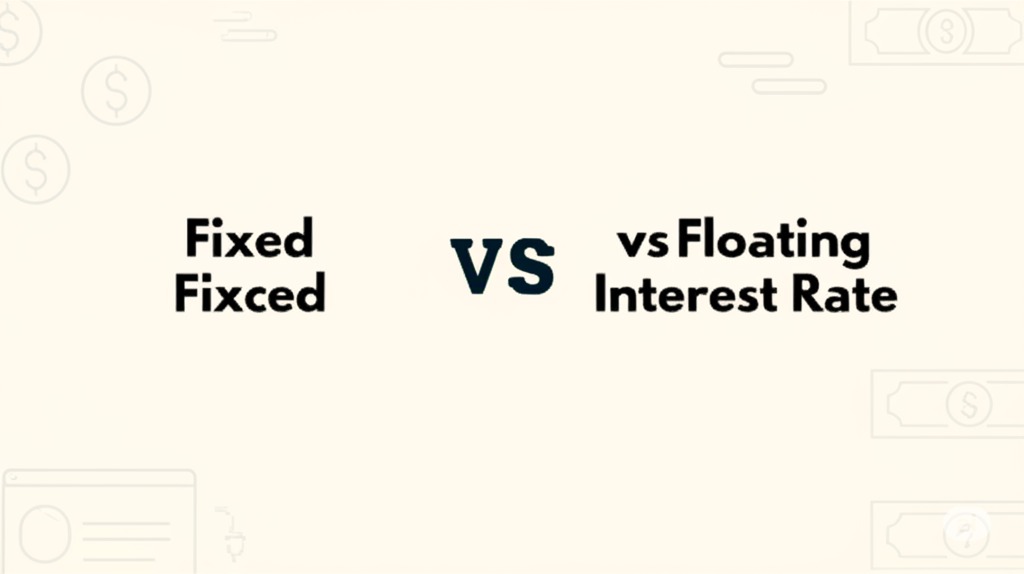Fixed vs Floating Interest Rate: What’s Better for Your Loan?
Choosing the right interest rate type for your loan can make a huge difference in your finances. Whether you’re applying for a home loan, personal loan, or business loan, understanding the difference between fixed and floating (variable) interest rates is crucial.
In this guide, we’ll break down the pros and cons of each, how they work in 2025, and help you decide which one suits your financial goals best.
What Is a Fixed Interest Rate?
A fixed interest rate stays the same throughout the loan tenure. If your loan has a fixed rate of 8%, you’ll pay exactly 8% interest every year until you finish repaying the loan.
Advantages of Fixed Rate
- Predictability: Your EMI remains the same, making budgeting easier.
- Protection from rate hikes: If market interest rates rise, your loan cost stays unchanged.
- Peace of mind: Less stress about fluctuating payments.
Disadvantages of Fixed Rate
- Typically higher initial rate: Fixed rates start higher than floating ones.
- No benefit from rate cuts: If market rates drop, you won’t get the lower rate automatically.
- Prepayment penalties: Some lenders charge fees for early repayment on fixed-rate loans.
What Is a Floating Interest Rate?
A floating (or variable) interest rate changes over time based on market conditions or benchmarks like RBI’s repo rate. For example, if your floating rate is “base rate + 2%,” and the base rate changes, your interest adjusts accordingly.
Advantages of Floating Rate
- Lower initial rates: Often starts lower than fixed rates.
- Benefit from rate cuts: If market rates decrease, your EMI reduces.
- Flexibility: Many floating rate loans allow easier prepayment without penalties.
Disadvantages of Floating Rate
- Uncertainty: Your EMI can increase if rates rise, affecting your budget.
- Complexity: Tracking rate changes and EMI fluctuations can be stressful.
- Possible sudden increases: Sharp hikes can significantly increase your EMI.
Fixed vs Floating: Which One Is Better in 2025?
Factors to Consider
| Factor | Fixed Rate | Floating Rate |
|---|---|---|
| Current Interest Rate Trends | Good if rates are low and stable | Better if rates are expected to fall |
| Your Risk Appetite | Suitable if you prefer stability | Suitable if you can handle fluctuations |
| Loan Tenure | Ideal for short to medium tenure | Better for longer tenure with rate drops |
| Prepayment Plans | Check for penalties | Usually flexible |
| EMI Budgeting | Easier to plan | Needs buffer for hikes |
Interest Rate Scenario in 2025
In 2025, with inflation concerns and economic recovery, central banks are likely to keep interest rates in a moderate range. Floating rates might be volatile but could trend downward if inflation eases.
When Should You Choose a Fixed Interest Rate?
- You have a fixed monthly income and want predictable EMIs.
- You expect interest rates to rise or remain stable.
- You plan to keep the loan long-term without prepayment.
- You are risk-averse and want to avoid surprises.
When Should You Choose a Floating Interest Rate?
- You expect interest rates to fall in the near future.
- You can handle EMI fluctuations without stress.
- You plan to prepay or close the loan early.
- You want to take advantage of lower initial rates.
How to Switch Between Fixed and Floating Rates?
Some lenders offer the option to switch from fixed to floating or vice versa during the loan tenure. This might involve:
- A nominal processing fee
- Interest rate revision
- Documentation and formal application
Check with your lender if you want this flexibility.
FAQs
Q1: Can I switch from fixed to floating rate after loan disbursal?
Yes, most banks allow switching but may charge a small fee.
Q2: Which loan type saves more money?
It depends on market conditions. Floating rates save money if rates fall; fixed rates protect when rates rise.
Q3: Do fixed-rate loans have prepayment penalties?
Often yes, but floating rate loans usually don’t.
Q4: How do I know if the floating rate is good?
Compare the lender’s base rate or MCLR and recent trends.
Final Thoughts
Choosing between fixed and floating interest rates depends on your financial situation, risk tolerance, and market outlook. If you want predictability and peace of mind, go fixed. If you can handle some uncertainty and want to benefit from potential rate cuts, floating may be the better choice.
In 2025’s dynamic economic environment, staying informed and reviewing your loan options regularly is the key to smart borrowing.
